To Make Mackerons
From the treasured pages of Medicinal and cookery recipes by John King
Written by John King

To Make Mackerons
"take a pound of almonds blanch them in hot water and put them into cold then dry them in a cloth and beate them in a stone morter drope in now and then a littel ros water to keep them from oyling and when ye are beate indifferent fine then put in as lite ros water as posibel then put in the whites of 4 eges whisk up to a froth and stor them well together and lay them out on papers with out wafers and back them on shets of tin and when ye are risen and have a fine coler & wel enough draw them and when ye are a littel cold take them of ye papers remeber to searce on suger when ye goe into ye oven and it will make them looke as if ye were icst"
Note on the Original Text
The recipe is written in the loose, instructive style of early modern English cookery, with little in the way of precise measurements or temperatures. Spellings are phonetic and variable: 'mackerons' for macaroons, 'oyling' for creaming or turning oily, 'searce on suger' for sifting sugar. Directions presume practical knowledge, giving only essential cues about color, texture, and handling. Egg sizes and almond varieties could vary, and recipe writers trusted the cook to use intuition. Abbreviations like 'ye' for 'the' are period-correct, and 'beate indifferent fine' means to grind to a moderate fineness—not a paste.

Title
Medicinal and cookery recipes by John King (1675)
You can also click the book image above to peruse the original tome
Writer
John King
Era
1675
Publisher
Unknown
Background
A delightful journey into the kitchens of the 17th and early 18th centuries, this collection, attributed to John King, brims with time-honored recipes, culinary wisdom, and flavors that once graced historic tables.
Kindly made available by
Folger Shakespeare Library
This recipe for 'mackerons' comes from manuscript V.a.490, compiled between 1625 and 1725, and associated with John King, a period when manuscript recipe collections flourished among the English gentry. Macaroons (or 'mackerons') of this period were among the earliest almond confections, predating and inspiring the French-style macaron we know today. The recipe reflects a time of global trade: almonds and rose water arrived via Mediterranean and Middle Eastern routes, and sugar had become both status symbol and flavoring. Such recipes were prized for festive tables and as confections gifted and displayed during banquets.

Originally, this recipe would have been made with a stone mortar and pestle to grind the almonds by hand, a linen or flaxen cloth for drying, and a whisk made of bundled twigs or fine wood for frothing the egg whites. Confections were baked on sheets of hand-beaten tin, with the mixture shaped and portioned onto sheets of paper. Sifting sugar would have been done through a fine sieve. Hot, wood-fired ovens required careful attention, judging doneness by color and lift.
Prep Time
20 mins
Cook Time
20 mins
Servings
18
We've done our best to adapt this historical recipe for modern kitchens, but some details may still need refinement. We warmly welcome feedback from fellow cooks and culinary historians — your insights support the entire community!
Ingredients
- 1 pound (16 ounces) blanched almonds
- 1–2 teaspoons rose water
- 4 large egg whites
- Caster sugar (for dusting)
Instructions
- To make historical 'mackerons', start with 1 pound (16 ounces) of blanched almonds.
- Blanch them by pouring boiling water over the almonds, letting them sit briefly, then slipping off their skins and cooling them in cold water.
- Dry thoroughly in a clean cloth.
- Grind the almonds in a food processor or mortar and pestle, adding a few droplets of rose water (no more than 1–2 teaspoons total) occasionally to prevent the nuts from becoming oily.
- When the mixture is finely ground but not a paste, whisk four large egg whites to a frothy texture, but not stiff peaks.
- Gently fold the beaten egg whites into the almond mixture until well blended.
- Spoon or pipe small mounds (about tablespoon size) onto parchment paper placed on baking trays (tin sheets in the past).
- Sift a generous layer of caster sugar over the tops before baking.
- Bake in a preheated oven at 300°F (150°C) for 18–22 minutes, or until risen and golden.
- Allow to cool slightly, then carefully remove from the paper.
- These are delicate, almondy, fragrant confections—a predecessor to the modern macaron.
Estimated Calories
140 per serving
Cooking Estimates
You will spend about 20 minutes preparing the almonds and mixing the ingredients. Baking takes another 20 minutes. Each serving contains about 140 calories if you make 18 macaroons from this recipe.
As noted above, we have made our best effort to translate and adapt this historical recipe for modern kitchens, taking into account ingredients nowadays, cooking techniques, measurements, and so on. However, historical recipes often contain assumptions that require interpretation.
We'd love for anyone to help improve these adaptations. Community contributions are highly welcome. If you have suggestions, corrections, or cooking tips based on your experience with this recipe, please share them below.
Join the Discussion
Rate This Recipe
Dietary Preference
Main Ingredients
Culinary Technique

Den Bockfisch In Einer Fleisch Suppen Zu Kochen
This recipe hails from a German manuscript cookbook compiled in 1696, a time whe...

Die Grieß Nudlen Zumachen
This recipe comes from a rather mysterious manuscript cookbook, penned anonymous...

Ein Boudain
This recipe comes from an anonymous German-language manuscript cookbook from 169...

Ein Gesaltzen Citroni
This recipe, dating from 1696, comes from an extensive anonymous German cookbook...
Browse our complete collection of time-honored recipes



